As a BBQ enthusiast, conquering the quintessential challenge of nailing the perfect quantity of succulent pulled pork for each guest is my forte. Whether it’s a cozy family meal or a grand backyard bash, grasping How Much Pulled Pork Per Person to prepare is crucial. Acknowledging the seasoned wisdom that adults typically savor about 1/3 pound while children delight in 1/4 pound for those irresistibly pulled pork sandwiches, I aim for precision to avoid the blunder of anyone leaving on an empty stomach.
To complement your BBQ planning needs, I’ve incorporated a Pulled Pork Calculator that efficiently calculates the raw pork amount, taking into account the inevitable shrinkage during cooking. Bid farewell to the guesswork and let the calculator ensure you Calculate Pulled Pork Amount with accuracy. Get ready to smoke that pork butt to tender perfection and craft the ultimate pulled pork recipe servings tailored for your gathering.
Key Takeaways
- Ensure proper pulled pork recipe serving sizes—typically 1/3 lb for adults and 1/4 lb for children.
- Without accompanying sides, you should consider increasing the portion to 1/2 lb per adult.
- Use the pulled pork calculator for precise BBQ planning and to buy the right amount of raw pork.
- Always factor in the weight reduction of pork after smoking to calculate consumable quantities correctly.
- Calculate extra pulled pork to have sufficient food for hearty appetites and unexpected guests.
Understanding Pulled Pork Serving Sizes
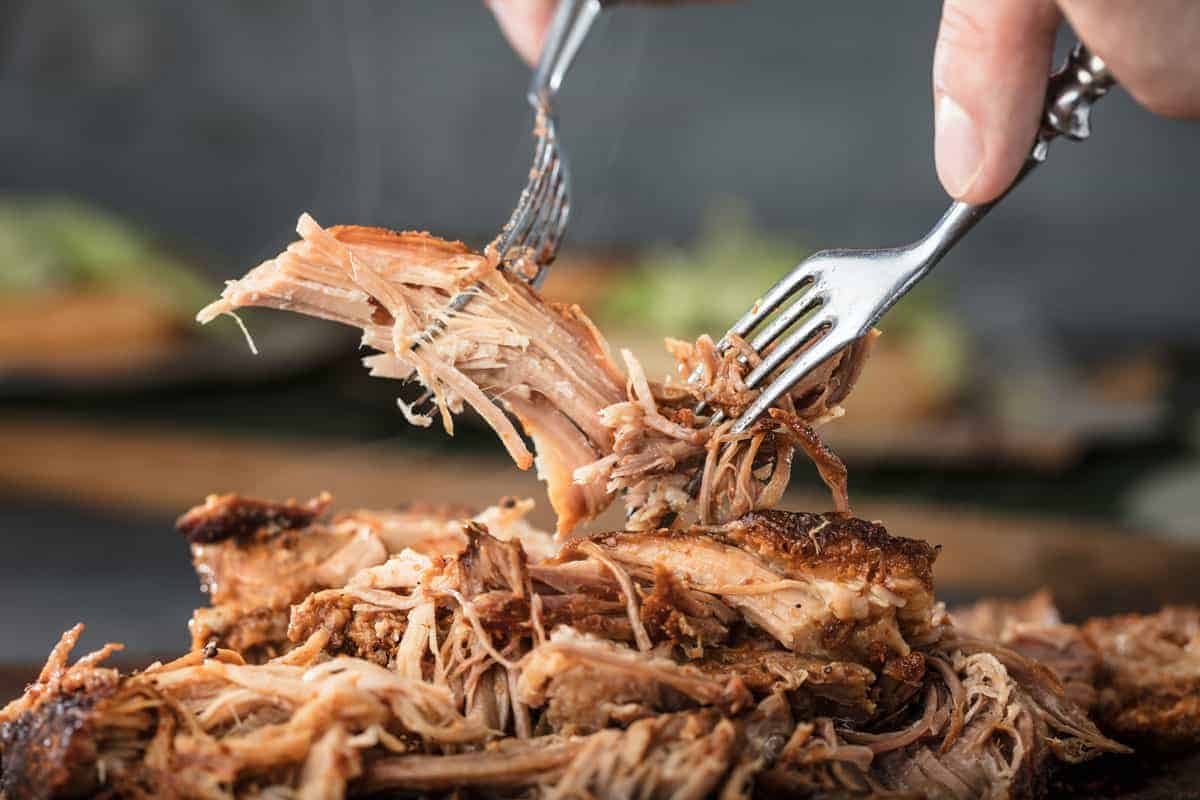
When I’m tasked with hosting a BBQ, my priority is to Determine Portion Sizes that will satisfy the crowd without going to waste. A balance must be struck, particularly when it comes to crowd-pleasers like pulled pork. It’s vital to consider not just the size of the crowd but the type of meal—whether it’s hearty pulled pork sandwiches or standalone, plateful servings.
Factors for Determining Portion Sizes
The key factors affecting portion sizes include the presence of sides and the form in which the pork is served. For example, if my menu features a variety of side dishes, I can safely estimate less pulled pork per person versus when it’s the star of the show without accompaniments. Moreover, the Pulled Pork Serving Size for adults and children must be carefully gauged to ensure everyone leaves the table with happy, full bellies.
Another consideration is the cooking process itself, which invariably leads to moisture loss and weight reduction. Whether I’m preparing a Pork Butt Portion or a Picnic Shoulder Serving, I must account for a significant decrease in weight post-cooking, especially if I opt for bone-in cuts.
Standard Serving Sizes for Adults and Children
A standard rule of thumb is assigning 1/3 pound of cooked pulled pork per adult and 1/4 pound per child, especially when enveloped in a fluffy bun as a sandwich. However, if the dinner plate lacks sides, I boost up the portions to satisfy solitary meat cravings—sometimes up to 1/2 pound for each adult.
I don’t want to be caught off guard by unexpected appetites, so I always round up my numbers. As for variations in cut weights and the inevitable shrinkage, here’s a handy calculation guideline based on the USDA’s yield data and personal experience:
| Cut Type | Starting Weight (lb) | Estimated Cooked Yield (lb) | Yield Percentage |
|---|---|---|---|
| Pork Butt | 8 | 4-4.5 | 50-56% |
| Picnic Shoulder | 8 | 4 | 50% |
| Bone-In Cuts | 8 | 3.6-4 | 45-50% |
To solidify my plans, I also incorporate my personal 5% rule—adding an extra buffer to the total weight purchased. This way, I’m prepared for hefty eaters or anyone who might arrive unannounced. It’s a matter of BBQ hospitality to ensure everyone’s content and to have leftover pulled pork that’ll be gobbled up in days to come.
Mastering the art of estimating the Pulled Pork Serving Size is crucial, particularly when I’m looking to impress my guests with my BBQ prowess. With these calculations and considerations in mind, I can adapt to various appetites and preferences, making every BBQ event I host a resounding success.
The Importance of Calculating Cooked Pulled Pork Weight
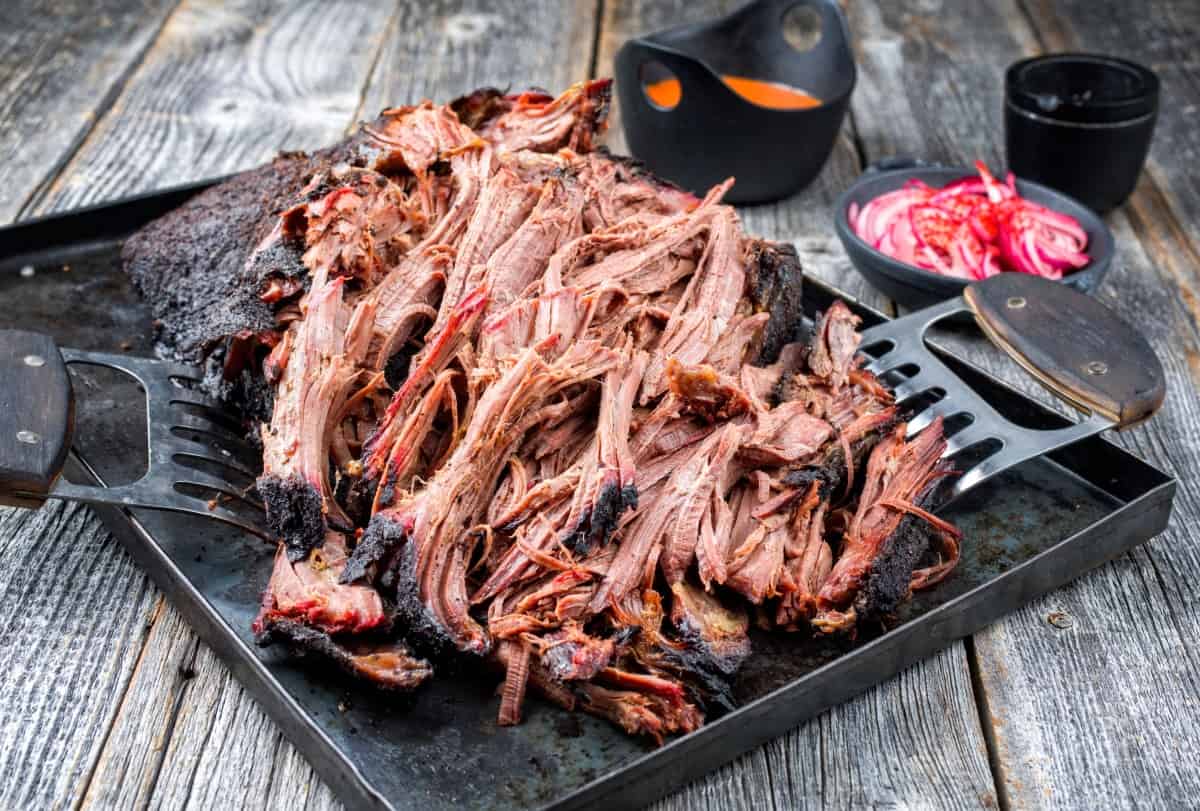
When orchestrating a BBQ, I’ve learned that knowing the Cooked Pulled Pork Weight post-smoking is pivotal. This is particularly crucial when I’m planning to serve pulled pork—be it for intimate family settings or extensive neighborhood gatherings. Using a Pulled Pork Estimator will ensure that every guest gets their hearty share, without food wastage or shortage, which could dampen the festive spirit.
Considering the substantial weight loss from raw to cooked state, I make an educated estimate that a safe assumption for my weight calculations is a 50% loss. Thus, an Accurate Meat Calculation becomes imperative. This process avoids the pitfall of underestimating the quantity of raw pork needed to satisfy the appetite of my guests and ensures the satisfaction of one and all.
The rationale behind this weight reduction is the cooking process, which involves dehydration and rendering out fat—both of which contribute to a lighter end product. Therefore, meticulous planning goes into the initial purchase to accommodate this inevitable shrinkage.
Understanding the dynamics of weight loss during cooking not only ensures adequate serving portions but also helps in budgeting and reducing unnecessary expenses.
- Use of estimators for calculating amounts effectively
- Considering moisture and fat loss for accurate portioning
- Ensuring every guest enjoys a bountiful BBQ experience
The table below provides a glance at the expected yield after cooking various cuts typically used for pulled pork. This serves as a quick reference for myself, a guide during shopping, and also when explaining to interested guests or fellow BBQ enthusiasts the reason behind certain portion sizes, particularly those curious about the transformation from raw pork to succulent pulled pork servings.
| Cut | Raw Weight (lb) | Expected Cooked Weight (lb) | Approx. Loss (%) |
|---|---|---|---|
| Pork Butt | 10 | 5 | 50% |
| Picnic Shoulder | 10 | 4.5 | 55% |
Savvy BBQ planners, including myself, know that building a reputation for throwing the perfect BBQ involves more than just grilling skills—it’s also about mastering quantities. With proper usage of a Pulled Pork Estimator, stress-free host duties are guaranteed as it manifests in guests relishing the right amount of flavorful, tender, and perfectly cooked pulled pork.

How to Calculate the Right Amount of Pulled Pork for Your Guests
When it comes to ensuring everyone at your BBQ leaves satisfied, Adjusting Pulled Pork Amounts is a vital part of the process. I take into account not just the headcount but the Guest Preference for Pulled Pork. For instance, knowing if there will be other options available such as brisket or chicken could impact the amount of pulled pork I prepare.
It’s not just about serving sizes; it’s about Tailoring BBQ Portions to fit the event. This might mean preparing a bit more for those who have a bigger appetite or less if I know that there are dietary restrictions or smaller appetites, such as with children. Here’s a quick tip: always round your numbers up. It’s better to err on the side of too much rather than too little, especially when you factor in the likelihood of second helping.
Adjusting Amounts for Guest Preferences
If you’re expecting hearty eaters at your BBQ event, it’s wise to tweak your quantities accordingly. In contrast, if the menu is extensive with a variety of dishes, you can likely scale back on the quantity per person. Determining the right amount is a balancing act that hinges on the profile of your guests. I make sure to consider everyone, including those unexpected plus-ones that always seem to appear.
Remember, it’s always better to have a little extra than not enough – no one likes a BBQ with scarcity of food, especially when it’s as mouth-watering as pulled pork.
Using the Pulled Pork Quantity Calculator
I cannot extol the virtues of the Pulled Pork Quantity Calculator enough. It’s an essential tool in my BBQ arsenal, perfectly suited for demystifying the complexities of portion planning. This clever little assistant simplifies BBQ preparation exponentially by taking average weight loss during cooking into account, thereby ensuring that everyone receives a suitable portion of deliciously smoked pulled pork.
| Guest Count | Raw Pork Needed (lbs) | Adjusted Raw Pork (lbs) |
|---|---|---|
| 10 | 7 | 7.35 |
| 20 | 14 | 14.7 |
| 50 | 35 | 36.75 |
| 100 | 70 | 73.5 |
Utilizing the calculated results from the Pulled Pork Calculator as a guide, I make accurate estimations for purchasing raw pork. It compensates for the typically anticipated 50% weight reduction during the cooking process, making it a reliable BBQ Portion Planning Tool.
With an eye for detail and a commitment to guest satisfaction, calculating the right amount of pulled pork becomes an exercise in precision—as precise as the smoking process itself. Rest assured, with a solid calculation strategy under your apron, your next BBQ event will have guests reveling in the perfect serving size of pulled pork, all thanks to a little mathematical foresight.
Expecting the Unexpected: Calculating for Extra Appetites

As an enthusiastic BBQ host, I must Calculate Extra Pulled Pork, ensuring ample servings for unexpected extra appetites. Instead of coming up short, I always advocate for preparing BBQ Extra Portions. This means adhering to a simple yet crucial principle: it’s better to have surplus pulled pork than face the dilemma of hungry guests reaching for an empty tray.
In my experience, Preparing for Hungry Guests is part of an essential BBQ calculus—built into every succulent batch of pulled pork I smoke. An effective strategy is to anticipate larger portions for those with a hearty hunger, so adding about a 5% buffer to my initial estimates guarantees that no one leaves unsatisfied.
Whether it’s a family gathering or neighborhood cookout, the BBQ credo I live by is abundantly clear: more is better. Not only does it account for those with larger appetites, but it warmly accommodates any surprise plus-ones as well.
To illustrate, here is a breakdown of how I incorporate that extra 5% into my calculations:
| Guest Count | Estimated Pulled Pork Needed (lbs) | 5% Extra Pulled Pork (lbs) | Total Pulled Pork to Prepare (lbs) |
|---|---|---|---|
| 20 | 13 | 0.65 | 13.65 |
| 40 | 26 | 1.3 | 27.3 |
| 60 | 39 | 1.95 | 40.95 |
| 80 | 52 | 2.6 | 54.6 |
| 100 | 65 | 3.25 | 68.25 |
Following this method allows me to serve with confidence, knowing that every guest will be afforded the chance to indulge in my BBQ craftsmanship.
- Calculating extra portions accommodates unexpected guests.
- An additional 5% ensures there are leftovers for those second helpings.
- Better to be in surplus than deficit when it comes to food at a BBQ.
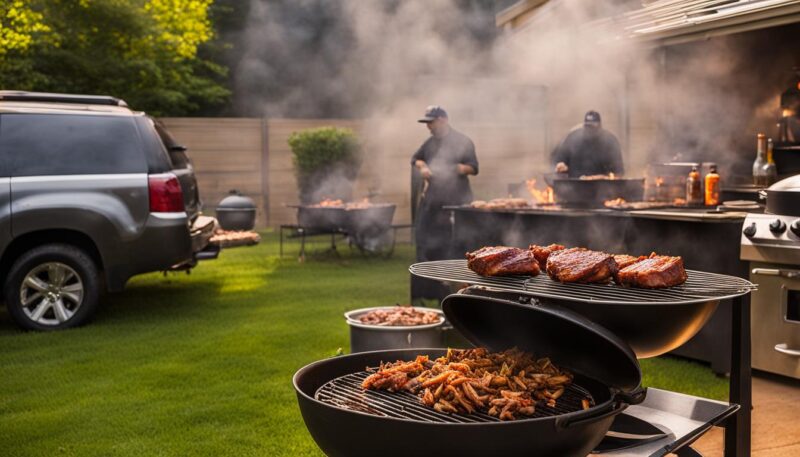
Armed with an accurate headcount and a thoughtful estimation of “just-in-case” pounds, I stand ready to satisfy the appetites of my guests, no matter how big or surprising they may be. This is the art of BBQ—a blend of culinary prowess and strategic pre-planning that culminates in the perfect feast. It’s not just about firing up the grill; it’s about firing up the generosity and spirit of sharing that makes BBQs an unforgettable experience.
Choosing the Best Cut: Pork Butt vs. Picnic Shoulder
When it comes to Selecting Pork Cut for that perfect BBQ, the debate between Pork Butt vs. Picnic Shoulder is as sizzling as the grills we cook them on. My preference often leans towards the robust and marbled pork butt. Known also as the Boston butt, its rich fattiness is a ticket to a moist and flavorful pulled pork experience, which is why many regard it as the Best Cut for Pulled Pork.
On the flip side, there’s the leaner picnic shoulder. It too has its merits—especially its skin, which when exposed to high heat, can transform into a crispy delight. Although it requires more finesse in cooking to reach tenderness, it’s a contender that can hold its own on the BBQ battlefield.
When I’m in the meat aisle, pondering over the plethora of pork, I consider the specific demands of my guests and the type of event I’m hosting. Adapting to preferences and expectations is integral, and that’s where the art of Selecting Pork Cut comes into play. Therefore, allow me to offer some insights into both options, laying bare their attributes and how they can influence your BBQ outcome.
| Characteristics | Pork Butt (Boston Butt) | Picnic Shoulder |
|---|---|---|
| Marbling | High (Favorable for Moisture) | Low (Requires Careful Cooking) |
| Bone Structure | Bone-in or Boneless | Typically Bone-in |
| Texture after Cooking | Tender and Juicy | Tender (if cooked correctly) |
| Best Cooking Method | Slow Cooking/Smoking | Slow Cooking/Smoking and Crisping Skin at High Heat |
| Typical Use in BBQ | Pulled Pork | Pulled Pork or Crisped Skin Dishes |
The choice between these two is never easy, for each has its strengths that appeal to the discerning BBQ maestros. I cherish the marbling in the pork butt because it promises a degree of forgiveness during the long smoking hours, almost guaranteeing an end product that’s rich and succulent.
When selecting the meat for my smoker, the visual assessment of marbling and the anticipated yield after cooking weigh heavily into my decision. It’s a practice honed through experience and respect for the craft of BBQ cooking.
- Honing in on the right cut for your BBQ ensures a sumptuous pulled pork result.
- Understanding the properties of Pork Butt vs. Picnic Shoulder will guide your selection process.
- Opting for the right cut sets the stage for a memorable pulled pork feast that’s bound to gather praise and leave guests eagerly anticipating your next BBQ event.
To round up, both pork butt and picnic shoulder are exemplary in their ways. But if I have to pick a champion in the Pork Butt vs. Picnic Shoulder face-off, my vote generally sways towards the former, purely for its reliable performance and undeniable crowd-pleasing abilities when it comes to producing the Best Cut for Pulled Pork.
Making Pulled Pork Go Further: Tips and Tricks
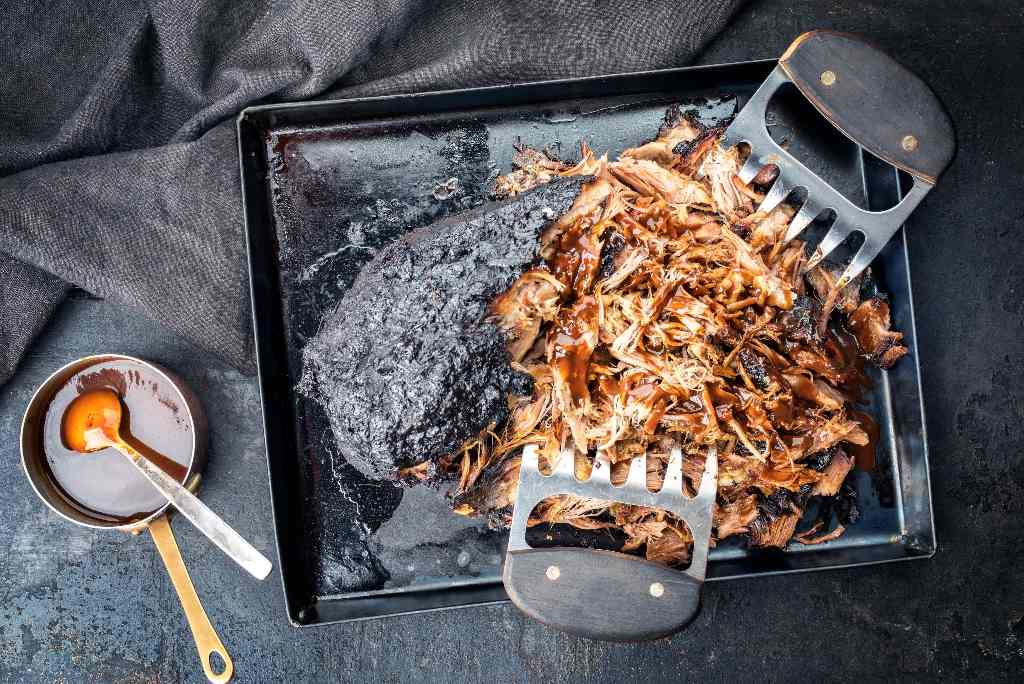
As I delve into the savory world of barbecue, one key strategy I’ve honed in on is Making Pulled Pork Stretch to accommodate a large gathering without compromising on taste or quantity. I’ve discovered the effectiveness of smartly pairing my main dish with Sides to Complement Pulled Pork, which not only enhances the meal but also helps in extending the main course.
Complementing with Sides and Fillers
Experience teaches me that a spread of hearty sides acts as a perfect buffer, adding volume and diversity to the BBQ feast while subtly reducing the quantity of pulled pork savored by each guest. Heavier dishes such as baked beans and potato salad are traditional BBQ side ideas that fill plates and satisfy appetites, ensuring the pulled pork is relished to the fullest but not overly relied upon.
Offering approximately 5-6 ounces of each side dish per person creates a balanced experience where the sumptuous flare of pulled pork isn’t overshadowed but rather complemented by the surrounding sides.
Here’s a glance at some prime side dish options and their suggested serving weights that contribute to Making Pulled Pork Stretch for a group of eight:
| Side Dish | Serving Size (oz) | Guest Count | Total Weight (oz) |
|---|---|---|---|
| Baked Beans | 6 | 8 | 48 |
| Potato Salad | 5 | 8 | 40 |
| Coleslaw | 5 | 8 | 40 |
| Cornbread | 3 | 8 | 24 |
Creative Serving Ideas
A touch of creativity can go a long way in presenting pulled pork in ways that excite and satisfy. From iconic Pulled Pork Sandwiches topped with a tangy, homemade coleslaw to original creations like incorporating pulled pork into a shepherd’s pie, these personalized touches not only allow for smaller servings of the meat but also elevate the overall dining experience.
Here are several Pulled Pork Creative Serving concepts I’ve used that won guests over and stretched my BBQ provisions:
- Loaded Pulled Pork Baked Potatoes
- Pulled Pork Tacos with a variety of toppings
- Pulled Pork Sliders for smaller, yet flavorful bites
Lastly, by offering a diverse menu, which may include other meat choices or vegetarian dishes, I ensure that my prized pulled pork can serve as one mouthwatering option amongst many, allowing it to extend further while guests explore a variety of tastes and textures.
In conclusion, it’s these very tactics I count on to ensure that every plate at my BBQ is brimming with delight, without fear of scarcity. My guests leave content, praising the BBQ Serving Concepts and the ample, yet somehow just-right, portions of tender, smoked pulled pork.
Selecting Quality Meat: What to Look For
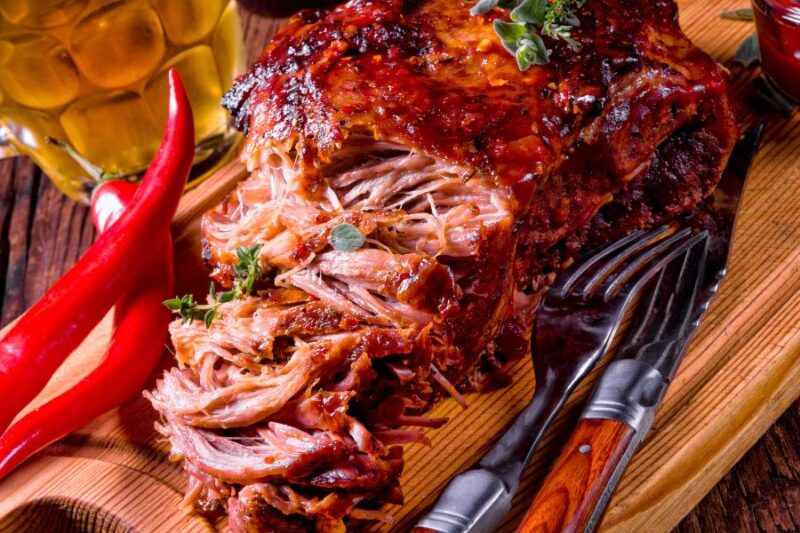
As a barbecue lover dedicated to producing the perfect meal, zeroing in on Quality Meat Selection is a step I never overlook. The fact is, when it comes to Choosing Pulled Pork Meat, an informed choice makes all the difference between good and great BBQ. The marbling of a cut, in layman’s terms, the fat woven within the muscle, is a prime indicator of moisture and tenderness, two hallmarks of exquisite pulled pork.
When I set out to purchase the Best Pork for BBQ, my eyes are on the lookout for uniform fat distribution. While marbling is essential, too much external fat can be wasteful, as it will be trimmed away. Hence, I prioritize balance—adequate internal fat to ensure juiciness and flavor without an excess that doesn’t contribute to the final dish. This understanding is vital both for amateur cooks at home and professionals aiming to delight their patrons.
The contenders for the heavyweight title of “Best Pork Cut” often boil down to the well-celebrated pork butt and the often-underrated picnic shoulder. Each has its own set of attributes that can make your BBQ a day to remember, or a day of “could’ve, should’ve.”
| Feature | Pork Butt | Picnic Shoulder |
|---|---|---|
| Marbling | Abundant, ensuring moist results | Lesser, but sufficient for tenderness when cooked properly |
| Outer Fat | Thick fat cap, often trimmed | A thinner layer, less waste |
| Cooking Suitability | Ideal for smoking and slow-cooking | Excellent when slow-cooked, with the bonus of crispy skin if desired |
Thus, when I face the decision of Choosing Pulled Pork Meat, both the pork butt and picnic shoulder are on the table. The former offers a consistently tender product with less risk, while the latter can present a range of textures and flavors that some may find preferable. My cooking method often dictates my choice: low and slow in my smoker usually means pork butt, while an afternoon of varied cooking could sway me toward the picnic shoulder.
Remember, the secret to a memorable BBQ is as much about the meal as it is about the meat, making the decision on the type of cut a significant player in the culinary experience.
- Seek out cuts with balanced marbling for optimal tenderness and flavor retention.
- Avoid excessive external fat to prevent waste and manage expenses.
- Consider your cooking method – smoking, roasting, grilling – to select the most suitable cut.
By arming oneself with knowledge on Quality Meat Selection and taking into account these finer points, any BBQ aficionado can elevate their pulled pork from a simple dish to a memorable feast.
Pulled Pork Calculator: Your BBQ Planning Assistant
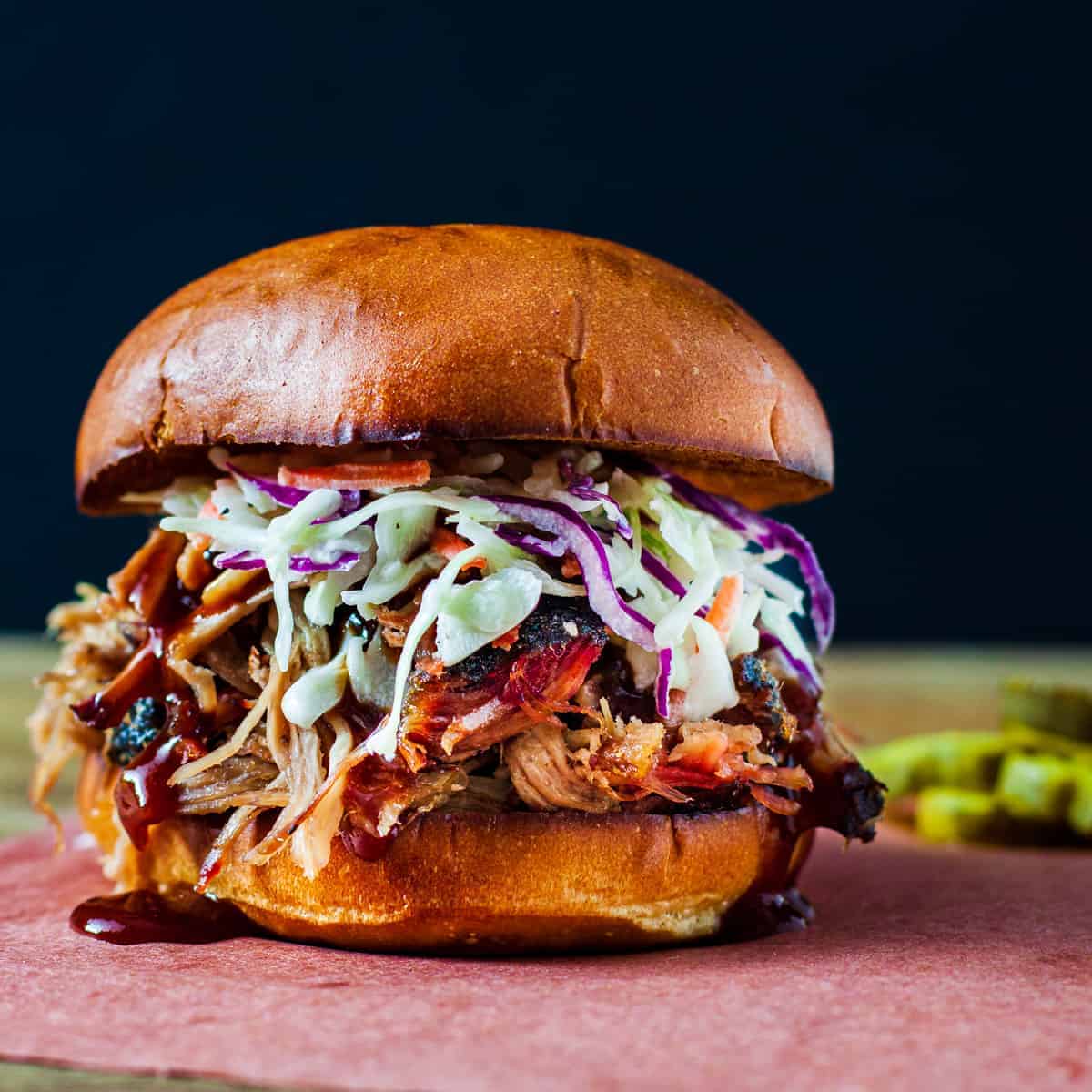
Preparing for a BBQ party requires meticulous planning, particularly when it comes to serving the centerpiece of the meal: pulled pork. With the help of the Pulled Pork Calculator, BBQ hosts like myself can breathe easier, knowing this tool provides a precise estimate of the amount of raw pork needed for an event. It’s an invaluable BBQ Planning Tool that factors in the anticipated weight loss of pork during the smoking process, which ensures that my guests will always have enough to satiate their BBQ cravings.
Accurately judging the amount of pulled pork necessary can seem daunting. However, as a Pulled Pork Planner, I rely on the calculator’s data-driven approach. This smart assistant removes guesswork and anxiety, providing peace of mind as I shop for the right cuts of pork for my guests. It assists in budgeting, reduces food wastage, and certifies the pleasure of seeing all content and well-fed after the feast.
Traditionally, the rule of thumb for pulled pork servings at a BBQ gathering has been ⅓ pound for adults and ¼ pound for children. However, cooking pulled pork is a transformative process, with raw meat yielding about half of its original weight once cooked. As such, anticipating portions with this in mind is essential to ensure no guest is left peeking into an empty pot.
With the Pulled Pork Calculator, one can effortlessly convert the headcount into the total pounds of raw meat required, making it a staple in any serious BBQ planner’s arsenal.
Let’s dive into the functionality of the Pulled Pork Calculator, shining a light on how it simplifies the planning process for both family cookouts and larger parties.
| Number of Guests | Recommended Raw Pork to Buy (lbs) | Total Cooked Pulled Pork Needed (lbs) | Actual Raw Pork to Purchase (lbs) |
|---|---|---|---|
| 10 | 6.67 | 3.33 | 6.7 |
| 20 | 13.33 | 6.67 | 13.4 |
| 50 | 33.33 | 16.67 | 33.5 |
| 100 | 66.67 | 33.33 | 67 |
The table above showcases the calculator’s suggestions for the amount of raw pork to buy based on the number of anticipated guests. By doubling the amount of cooked pulled pork needed, it ensures that despite the natural weight loss during cooking, there will be ample food for everyone. This foresight saves me from last-minute runs to the butcher and the embarrassing scenario of running short on food.
- Enter the number of guests attending the BBQ into the calculator.
- Receive the recommended amount of raw pork to purchase.
- Adjust for a 50% weight reduction through the cooking process.
- Shop confidently, knowing you have sufficient pork for the event.
This methodical approach to BBQ planning is a testament to the digital age empowering us to host with ease. My use of the Pulled Pork Calculator has consistently resulted in lavish spreads that leave my guests satiated and impressed. More importantly, it epitomizes the perfect blend of tradition and technology, elevating the craft of BBQ planning into an effortless art.
Preparation Tips for the Perfect Pulled Pork

As a seasoned pitmaster, my expertise in creating that perfect batch of pulled pork lies in the meticulous preparation stages. I’ve discovered that the secrets to a Flavorful BBQ Pork that tantalizes the taste buds are marinating and seasoning, followed by the patience of the smoking process.
Marinating and Seasoning for Flavorful Results
Laying down the foundation for Flavorful BBQ Pork starts well before the meat hits the grill. It’s in the Pulled Pork Marinating Tips where the magic begins, with a concoction of spices and liquids that brings out the richness and depth of the meat’s flavor. I always encourage a generous application of seasoning, as it works to tenderize and deeply infuse the pork with robust character.
Investing time in the marinating process ensures that each strand of the pulled pork carries with it the melody of flavors intended for a BBQ masterpiece.
- Creating a robust spice rub mix: salt, paprika, garlic powder, and a hint of brown sugar for balance
- Ensuring even coverage for the seasoning: coat each inch of the pork butt or shoulder for consistent flavor
- Marinating time: overnight or for up to 24 hours to allow deep penetration of the spices
Mastering the Smoking Process
The act of smoking pork is an art, one that is accentuated by Pulled Pork Smoking Tips and my commitment to the Slow-smoked Pork Technique. Controlling cooking temperatures and selecting the right wood, be it hickory or oak, provides that signature smokiness we all crave in a tender, mouthwatering BBQ pork.
Precision in the smoking process is akin to conducting an orchestra; every element must work harmoniously to create a symphony of flavors.
- Maintaining low temperatures around 225°F to ensure the pork is cooked thoroughly without drying out
- Choosing wood that complements pork: apple or cherry for a sweeter touch, hickory for a classic smokey profile
- Monitoring the meat’s internal temperature to hit that sweet spot of around 195°F to 205°F, perfect for pulling
Mastering these techniques is fundamental in serving up a feast that will be remembered long after the last ember has cooled. Here’s a quick look at some of the seasonings and wood types that elevate my BBQ:
| Seasoning | Type of Wood | Flavor Profile |
|---|---|---|
| Classic BBQ Rub | Hickory | Strong and Earthy |
| Sweet and Spicy Mix | Cherry | Fruity and Mild |
| Herb Infused Rub | Apple | Sweet and Subtle |
This table is a blueprint for the curious and aspiring BBQ aficionados who wish to replicate the allure of “11 out of 10” pulled pork. Through these methodologies, I guide my pork from humble beginnings to a celebration of smoky, seasoned magnificence.
Leftovers: Storage and Creative Second-Day Dishes
As an adept BBQ planner, one of the aspects I pay meticulous attention to is Storing Pulled Pork. Proper storage is paramount to maintaining the flavor and safety of the food, ensuring that today’s feast becomes tomorrow’s treat. For this purpose, using airtight containers is not up for debate—it’s a necessity. Once safely sealed, I promptly refrigerate or freeze the pulled pork, taking into account the quantity of leftovers and the expected consumption timeline.
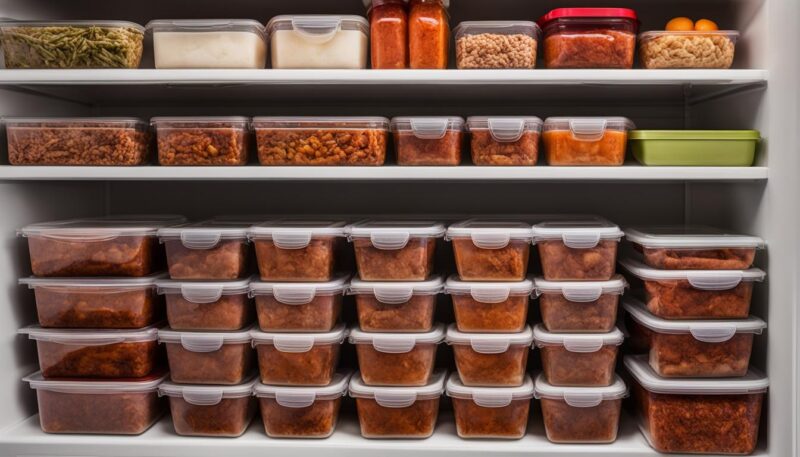
The conversation, however, gets more intriguing when considering the plethora of Second-Day Pulled Pork Dishes one can concoct. I pride myself on transforming leftovers into innovative meals that prolong the enjoyment of my BBQ labor. Below are some of my go-to Leftover Pulled Pork Recipes that not only economize food but also bring heartwarming variety to the table:
- Pulled Pork Shepherd’s Pie: A soulful dish layering pulled pork with veggies and creamy mashed potatoes, gratin-baked to a golden crisp.
- Pulled Pork Stew: Stewing pork with root vegetables, potatoes, and a rich broth creates a comforting meal for those cooler evenings.
- Pulled Pork Fried Rice: Adding pulled pork to a quick stir-fry with rice and vegetables combines classic Asian flavors with the smokiness of the BBQ.
Transforming leftovers isn’t merely about recycling food; it’s an art of reinvention, turning what could be mundane into something spectacularly satisfying.
For those curious about shelf life and storing pulled pork, here’s a handy reference on how to efficiently extend the longevity of your BBQ masterpiece:
| Storage Method | Shelf Life | Tips |
|---|---|---|
| Refrigerated (in Airtight Container) | 3-4 Days | Keep at or below 40°F |
| Frozen (in Airtight Container) | 2-6 Months | Freeze in portion-sized packages for easy thawing |
By adhering to these storing tips for pulled pork leftovers and exploring second-day dishes, one can easily enhance the home dining experience. The versatility of pulled pork renders it a fantastic ingredient that injects robust flavor into creative recipes. This strategic approach to leftovers guarantees not a morsel of my BBQ success goes to waste.
Catering Insights: Serving Pulled Pork to a Large Crowd
When I cater to a large event, the cornerstone of stress-free service is the strategic planning of Pulled Pork Bulk Purchase. To provide everyone with a sumptuous plate of Catering BBQ Pulled Pork, I calculate portions based on a few established tenets of crowd catering. My goal is to ensure a plentiful supply for a Large Crowd Pulled Pork experience that’s as memorable as it is flavorful.
Calculating Bulk Purchases
To calculate bulk purchases effectively, I begin by estimating portions per person, reflecting on the average appetites and potential weight loss of pork during cooking. With this approach, I can determine the ideal quantity for a Large Crowd Pulled Pork event. Not to overlook, I ensure to factor in a margin not only for sizable appetites but also for the welcome surprise of unanticipated guests—a nod to the lesson numbered 13 in catering: Always expect the unexpected.
It’s not merely about the quantity; it’s about the assured satisfaction of each guest with a plate of perfectly smoked pork.
| Guest Count | Average Portion (lbs) | Total Needed Before Cooking (lbs) | Final Weight Post Cooking (lbs) |
|---|---|---|---|
| 50 | 1/3 (Adult) | 50 | 25 |
| 100 | 1/3 (Adult) | 100 | 50 |
| 200 | 1/3 (Adult) | 200 | 100 |
| 300 | 1/4 (Child) | 100 | 50 |
Streamlining the Serving Process
My proficiency in Serving Pulled Pork Efficiently has taught me the virtues of two predominant serving styles: the controlled portions of cafeteria style, and the personalized selectiveness of buffet style. Opting for one over the other is a decision made with logistic and guest preference in mind, essential components for an effective BBQ Serving Strategy.
- Cafeteria style safeguarding equitable distribution.
- Buffet style catering to varied tastes and preferences.
Within the buffet framework, I often advise leading with sides and appetizers. It’s a subtlety within the buffet line, encouraging guests to fill their plates with starters and assess how much main course meat to take, aligning with a well-thought-out plan to Catering Serve Pulled Pork to a satiated crowd.
Conclusion: Your Blueprint for BBQ Party Success
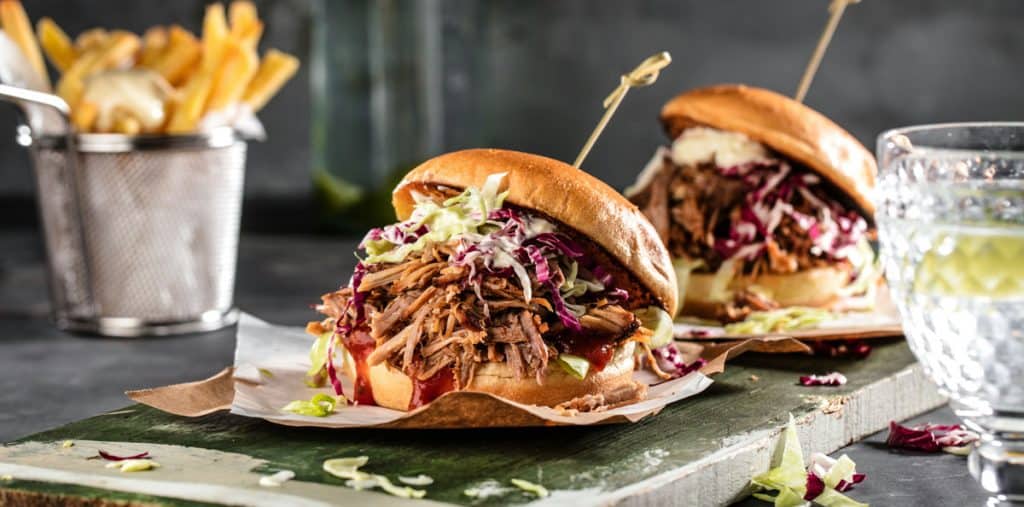
Reflecting on the robust journey of BBQ planning, my role in orchestrating a BBQ Party Success story is marked by attentive calculation and conscious selection of meats. The Perfect Pulled Pork Guide is not just a set of instructions; it’s an assurance of contented smiles and heartfelt praise for a meal well served. Driven by experience and the support of tools like the Pulled Pork Calculator, my Complete BBQ Planning guarantees not just adequate, but abundant servings to match the enthusiasm of a festive gathering.
Each step taken, from discerning the optimal portion sizes to the nuances of meat selection, caters to the promise of a bountiful table. Hence, I always look to offer that little extra, an added pound or two of pork, in the spirit of generosity and preparedness. Serving pulled pork isn’t merely a function of the gathering; it’s a celebration in itself, fostering joyful moments over a meal that’s tender, flavorful, and just right.
This barbecue chronicle I’ve shared with you blends the spirits of tradition and gastronomy. I hope that, with these insights, you too can help a BBQ event with finesse—where the pulled pork is succulent, the guests are delighted, and the memories linger long after the coals have dimmed. May your next BBQ be a testament to careful planning and unrivaled hospitality, rejoicing in the essence of communal dining and the pleasures of home-smoked cuisine.
FAQ
How much-pulled pork should I plan per person for a BBQ?
For a BBQ, you should plan on approximately 1/3 pound of pulled pork per adult and 1/4 pound per child for sandwiches. If you’re not serving sides, increase the amount to 1/2 pound per adult. Keep in mind that these are estimates and appetites can vary.
How do I determine the portion sizes for pulled pork?
Portion sizes can be influenced by several factors including whether the pulled pork is the sole dish or accompanied by sides. Generally, 1/3 pound per adult and 1/4 pound per child are good starting points for sandwiches. If serving stand-alone plates of pulled pork, aim for 1/2 pound per adult.
Why do I need to calculate cooked pulled pork weight?
Calculating cooked pulled pork weight is important because, during the cooking process, pork can lose about 40-50% of its initial weight. This is due to moisture loss, trimming fat, and removing bones, especially in cuts like pork butt or picnic shoulder which typically start with more weight than what ends up on the plate.
How do I adjust the amount of pulled pork for my guests’ preferences?
You can adjust the amount of pulled pork depending on the variety of other meats served, whether there are hearty eaters, or if substantial side dishes are provided. Always round up to ensure there’s enough for everyone, including seconds or unexpected guests.
What is a pulled pork quantity calculator and how does it help?
A pulled pork quantity calculator is an online tool that helps you determine how much raw pork is needed based on the number of guests, size of servings, and expected shrinkage during cooking, which ensures that all guests receive a proper portion without wasting food.
How can I prepare for extra appetites at my BBQ?
To prepare for extra appetites at your BBQ, consider increasing the amount of pulled pork by about 5% more than your initial calculation. This allowance ensures that you have enough for those with larger appetites, unexpected guests, or anyone who wishes to have seconds.
Which cuts should I choose for pulled pork, pork butt, or picnic shoulder?
The choice between pork butt or picnic shoulder depends on personal preference and cooking style. Pork butt, also known as Boston butt, is marbled with fat and ideal for succulent pulled pork. The picnic shoulder is leaner and requires careful cooking but can also produce excellent pulled pork if prepared correctly.
How can I make pulled pork go further at my BBQ?
To make pulled pork go further, pair it with heavier side dishes like potato salad or baked beans. You may also serve it in different formats, such as topping sandwiches with hearty coleslaw or turning it into a main ingredient in dishes like pulled pork shepherd’s pie.
What should I look for when selecting quality meat for pulled pork?
When selecting quality meat for pulled pork, look for cuts with good marbling and a consistent distribution of fat. Choose fresh meat with a rich color and avoid cuts that are excessively tough or have too much connective tissue, as these may not render down as well during cooking.
How can I ensure flavorful pulled pork?
To ensure flavorful pulled pork, marinate or apply a spice rub generously ahead of cooking time. Slow-smoke the meat at a low temperature to infuse it with smoky flavors and keep it tender. Experiment with different wood chips to add unique flavor notes to your pulled pork.
What are some creative second-day dishes using leftover pulled pork?
Leftover pulled pork can be transformed into a variety of dishes including tacos, pulled pork pizza, enchiladas, stews, or as a protein addition to salads. Get creative and integrate it into any dish that could use a flavorful and tender meat addition.
How should pulled pork be served to a large crowd?
When serving pulled pork to a large crowd, consider the serving style – cafeteria or buffet – and calculate bulk purchase quantities based on the number of guests. Ensure there are even portions and consider placing side dishes first in the buffet line to encourage balanced plate filling.

